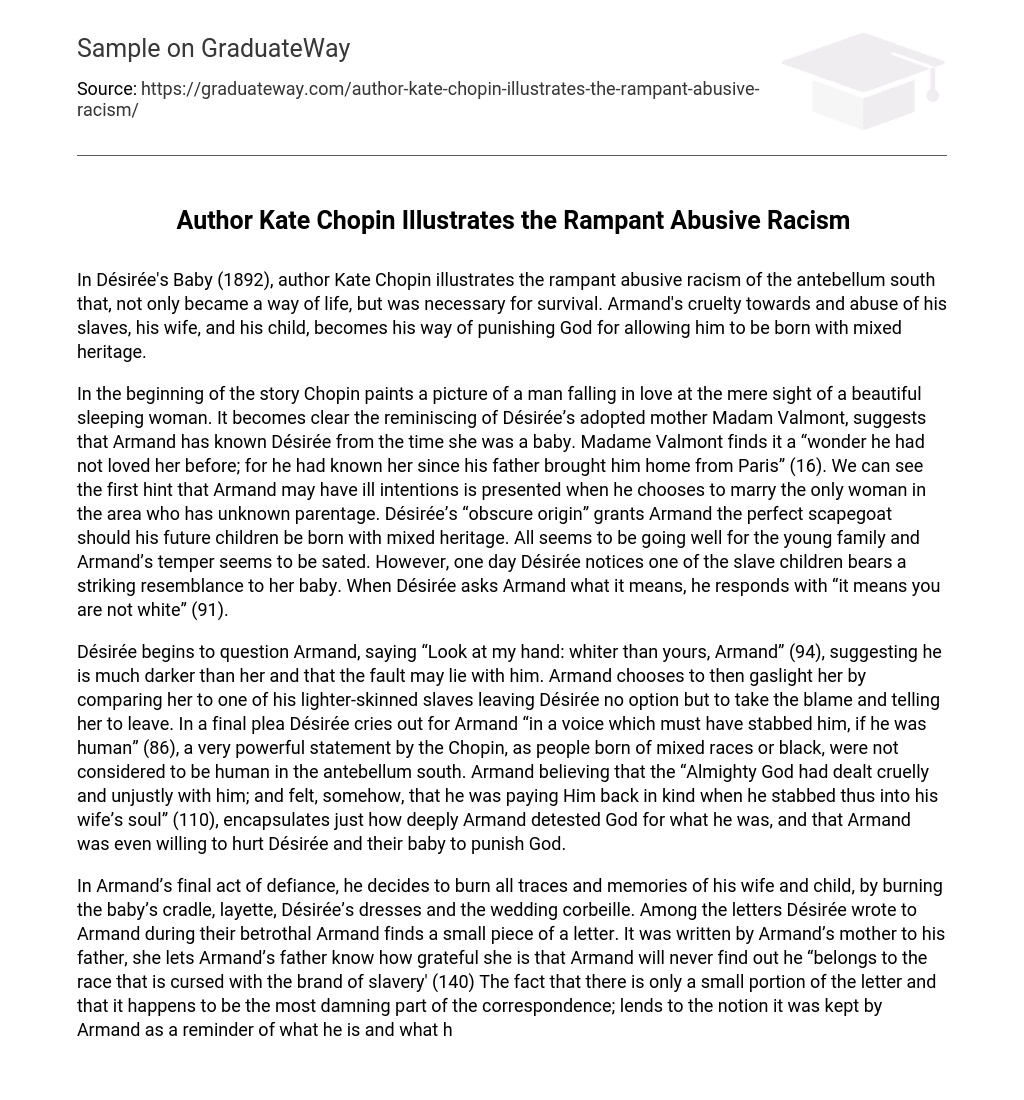In Désirée’s Baby (1892), author Kate Chopin illustrates the rampant abusive racism of the antebellum south that, not only became a way of life, but was necessary for survival. Armand’s cruelty towards and abuse of his slaves, his wife, and his child, becomes his way of punishing God for allowing him to be born with mixed heritage.
In the beginning of the story Chopin paints a picture of a man falling in love at the mere sight of a beautiful sleeping woman. It becomes clear the reminiscing of Désirée’s adopted mother Madam Valmont, suggests that Armand has known Désirée from the time she was a baby. Madame Valmont finds it a “wonder he had not loved her before; for he had known her since his father brought him home from Paris” (16). We can see the first hint that Armand may have ill intentions is presented when he chooses to marry the only woman in the area who has unknown parentage. Désirée’s “obscure origin” grants Armand the perfect scapegoat should his future children be born with mixed heritage. All seems to be going well for the young family and Armand’s temper seems to be sated. However, one day Désirée notices one of the slave children bears a striking resemblance to her baby. When Désirée asks Armand what it means, he responds with “it means you are not white” (91).
Désirée begins to question Armand, saying “Look at my hand: whiter than yours, Armand” (94), suggesting he is much darker than her and that the fault may lie with him. Armand chooses to then gaslight her by comparing her to one of his lighter-skinned slaves leaving Désirée no option but to take the blame and telling her to leave. In a final plea Désirée cries out for Armand “in a voice which must have stabbed him, if he was human” (86), a very powerful statement by the Chopin, as people born of mixed races or black, were not considered to be human in the antebellum south. Armand believing that the “Almighty God had dealt cruelly and unjustly with him; and felt, somehow, that he was paying Him back in kind when he stabbed thus into his wife’s soul” (110), encapsulates just how deeply Armand detested God for what he was, and that Armand was even willing to hurt Désirée and their baby to punish God.
In Armand’s final act of defiance, he decides to burn all traces and memories of his wife and child, by burning the baby’s cradle, layette, Désirée’s dresses and the wedding corbeille. Among the letters Désirée wrote to Armand during their betrothal Armand finds a small piece of a letter. It was written by Armand’s mother to his father, she lets Armand’s father know how grateful she is that Armand will never find out he “belongs to the race that is cursed with the brand of slavery’ (140) The fact that there is only a small portion of the letter and that it happens to be the most damning part of the correspondence; lends to the notion it was kept by Armand as a reminder of what he is and what he stands to lose. Armand’s choice to burn away all proof of his heritage makes it clear he knew all along he was not white. The possibility of fathering a mixed race baby was very high and he needed to find someone to take the blame if that happened. When he saw Désirée sleeping he remembered her story and he made his move. This highlights just the level of cruelty he had in his willingness to destroy the life of another to secure his. Even in the end Armand was more concerned with getting back at God for his situation than for the lives of his wife and child. In his heart Armand would always know the truth he “belongs to the race that is cursed with the brand of slavery” (140). His ultimate punishment is knowing his lineage ended in flames.





